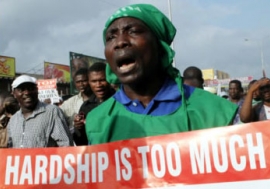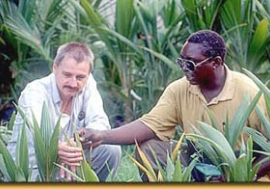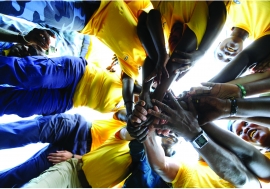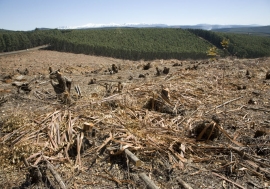Closing Ghana’s national poverty gap
Closing Ghana’s national poverty gap
Many of the women at the workshop of the Pagsung shea butter association are in their forties and fifties. Previously, each had collected and processed shea nuts as an individual, but earned so little she could barely get by. “We found if we came together we could make more and sell more,” explains Safiya Hassan, a recent university graduate who is helping the women.
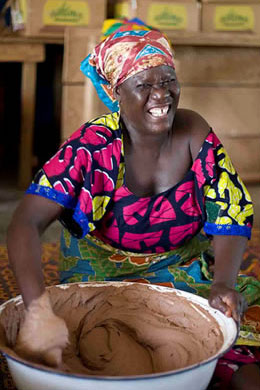 Mixing shea butter for soap production in Tamale, the capital of Ghana’s Northern Region: For poor women, even modest increases in their incomes can make a big difference.
Mixing shea butter for soap production in Tamale, the capital of Ghana’s Northern Region: For poor women, even modest increases in their incomes can make a big difference.The association now includes 13 groups of shea producers, all women, in Ghana’s Northern Region. Together they are able to produce more than 20 tonnes of shea butter per month. Much of this, in the form of high-quality shea soap and creams, is supplied to a Japanese company. As a group, the women are earning an additional profit of 10 Ghana cedis (US$11) for every 100 kilogrammes, compared to what they made as individual producers. That modest extra income has already changed the lives of many of the women.
“We make them dream, and dream big,” says Adisa Yakubu, executive director of the non-governmental Africa 2000 Network–Ghana and coordinator of the shea butter project. The project is also supported by the UN Development Programme (UNDP) and Japan, as part of that country’s cooperation programme with Africa, known as the Tokyo International Conference on African Development (see Africa Renewal, August 2008).
The shea project is still only a few years old, and has many problems to overcome. But that has not stopped its members from seeking to help other shea producers in the Northern Region, as well as in the Upper West and Upper East regions yet farther north. They have learned improved production techniques from women elsewhere, and are in turn planning to teach selected “master trainers” from all three of Ghana’s northern regions. Making such wider connections “has been one of our greatest achievements,” says Ms. Yakubu.
The north excluded
Tackling poverty is especially difficult in the north, and even small changes can have a noticeable impact. Across the country, Ghana’s robust economy has contributed to considerably improving the well-being of its people, with the proportion of Ghanaians living in poverty falling from 52 per cent in 1991–92 to 29 per cent in 2005–06, according to estimates by the Ghana Statistical Service. Ghana is thus on track to meet the poverty-reduction target of the Millennium Development Goals (MDGs) adopted by world leaders in 2000.
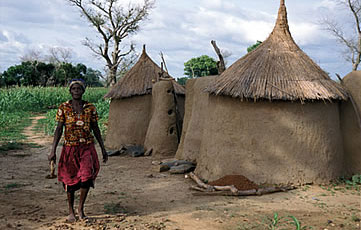 A village near Bolgatanga, in northern Ghana: Special programmes are needed to overcome the north’s heavy concentrations of poverty, poor climate and limited economic opportunities.
A village near Bolgatanga, in northern Ghana: Special programmes are needed to overcome the north’s heavy concentrations of poverty, poor climate and limited economic opportunities.But Ghana’s north has largely been excluded from that broader trend. The incidence of poverty in the Northern Region declined only slightly over the same period, from 63 per cent to 52 per cent. In the Upper West Region it remained static, at 88 per cent, while in the Upper East Region it actually increased, from 67 per cent to 70 per cent.
According to UNDP’s Ghana Human Development Report 2007, these three regions “harbour the poorest of the poor.” So while Ghana — unlike many other countries in sub-Saharan Africa — has made some notable progress on some of the MDGs, that process has been very uneven within the country. Segments of the population have been left behind in other parts of Ghana as well, especially in the large urban centres in the south. Yet the worst indicators are concentrated in the north.
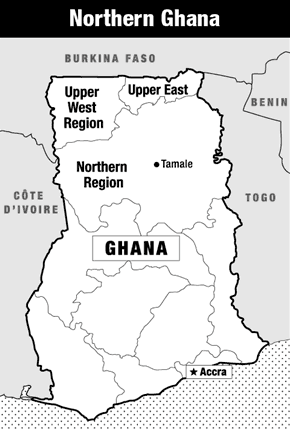
Such geographic disparities are not unique to Ghana. Many countries in Africa and other parts of the world are marked by regional inequalities, a reality that tends to get lost in discussions that focus mainly on national averages.
Ghanaian development experts, international aid agencies and residents of the north argue strongly that much more needs to be done to narrow the country’s regional divide. According to Charles Abugre, a Ghanaian economist and head of policy and advocacy for the non-governmental Christian Aid, Ghana will not be able to meet all the MDGs unless “deliberate government policies” are put in place to close the gap between north and south.
Above all, says John Nabila, a traditional paramount chief in the Northern Region’s West Mamprusi district, northern Ghana needs a concerted and conscious national effort to increase investments in education, health and economic development. “We are just hoping for the day we can bridge the gap between the regions,” he told Africa Renewal.
Geography and climate
Northern Ghana falls short by almost all indicators, and has significantly lagged behind the south since the colonial era, notes Mr. Nabila, who is also a professor of geography at the University of Ghana and the Northern Region’s representative on the Council of State, a body that advises the government on policy issues.
One hindrance is geography. The three northern regions are far from the ports, roads, railways, markets, industrial centres and fertile farming areas that help stimulate greater economic and human development in southern Ghana.
“The roads are poor,” says Mr. Nabila. The difficulty and high cost of transport hamper economic activity. This is one of the biggest challenges facing the shea producers in Tamale, whose exports to Japan must be carried by truck to the port of Accra on the coast before they can be loaded onto ships. Such costs cut into the profits the women can earn.
In many respects, the situation confronting the three northern regions is similar to that of the landlocked countries across Ghana’s northern borders, Burkina Faso, Mali and Niger, notes Ghanaian economist Cletus Dordunoo, one of the editors of the Ghana Human Development Report. “The landlocked countries share a similar level of education, and the occupations that they undertake are very similar too,” he told Africa Renewal. “They do a lot of cattle rearing and they produce crops such as shea nuts and cassava.” Moreover, those countries are “also deprived of these very things, infrastructure and basic facilities in education, health.”
The climate in northern Ghana is also close to that of the arid, wind-swept Sahel farther north. Farmers and livestock herders depend on scarce and erratic rainfall. Last year, notes Mr. Nabila, the short rainy season began as it usually did in May, and farmers planted their crops. “They were all looking forward to a bumper harvest, and suddenly the rain ceased. All the crops died. Then the heavens opened up, and we had floods.”
Poverty and the general lack of opportunities prompt many young people to migrate out of the north, observes Mr. Dordunoo. “They come down south just to eke out a living.”
Change in policies
Following independence in 1957, successive governments launched various initiatives to promote some economic development in the north, including widespread irrigated rice farming projects.
“Then came the World Bank,” explains Mr. Nabila. Economic liberalization policies promoted by the Bank led to the removal of government subsidies for agricultural inputs, irrigation schemes and farm extension services. Meanwhile, tariffs on imported rice were also cut, flooding the domestic market with cheaper rice from Asia.
Unable to compete, nearly half a million rice farmers, many of them in the north, were driven out of business, and domestic rice production fell drastically. Only about 100,000 rice farmers remain. “The rice industry collapsed,” complains Mr. Nabila. “Because of that change in policies, the whole country has suffered.”
Little schooling, poor health
One consequence of the north’s limited development is that few resources can be generated from within the region for essential social services. While nearly 70 per cent of all school-age children are enrolled in primary schools nationally, in the Northern Region the rate is just 50 per cent and in the Upper West and Upper East regions only 51 per cent and 56 per cent, respectively. The three northern regions can claim only about half the national secondary-school enrolment rate. Some three-quarters of all adults in the north are illiterate, compared with 43 per cent nationally.
As elsewhere in Ghana, special efforts have been made over the past decade to get more children into school. Poor families receive small grants when they enrol children, and school feeding programmes provide an additional incentive. In areas where the school feeding programme has been introduced, notes Mr. Dordunoo, “enrolment has so increased that infrastructure, school buildings, facilities are not able to cope with the increase.”
Some improvements in health have also been registered. Between 2003 and 2006, infant mortality rates were cut by more than half in the Northern and Upper East regions, and by a quarter in the Upper West.
But overall, health care remains poor. The three northern regions together have less than 9 per cent of Ghana’s hospitals, although they account for more than 17 per cent of its total population. The ratio of health clinics to population is only slightly below the national average, but since the north is vast, most people must travel much longer distances and the extra costs can be prohibitive for the poor.
Disparities in health costs can also be serious within the north itself. According to one study cited by the UNDP report, the cost of treating malaria accounts for just 1 per cent of the income of rich households in northern Ghana, but 34 per cent of the income of poor households in the region.
‘Dehumanizing cultural practices’
Across most social and economic indicators — from school enrolment to health to access to land — northern women and girls fare far worse than their male counterparts. That is true across Ghana (as in most countries worldwide), but the north in particular is influenced by the persistence of “dehumanizing cultural practices,” says the Ghana Human Development Report.
School enrolment in the north has been hampered by the involvement of children in farm and domestic labour, notes Mr. Dordunoo. That has been a constraint especially for girls, because of prevalent attitudes that girls “shouldn’t go to school.” Female genital cutting remains widespread. “Those practices are still there, even though they are declared illegal.”
Other practices are also common. Many young girls are abducted or forced into marriage at an early age. In the Northern Region only 2 per cent of landholdings are held by women, and in Upper West just 4 per cent.
Widows have few rights to inheritance. That is one reason the shea butter project in Tamale is so important, notes Ms. Yakubu. Many members of the shea association are in fact widows, with hardly any alternative sources of income or support. The modest incomes they can now earn have made it possible for some to build houses, buy land or secure medical care.
Many countries in Africa and other parts of the world are marked by regional inequalities, a reality that tends to get lost in discussions that focus mainly on national averages.
In a few respects, women in the north have made some symbolic gains. During the last parliamentary election in 2004, four women were elected in the Northern Region. They accounted for about 15 per cent of the deputies in the region, marginally higher than the 11 per cent rate for Ghana as a whole.
The social situation is complicated by the north’s ethnic patchwork. There are about 15 different ethnic groups in the Northern Region alone, with varied histories, customs and traditions. While most get along well, tensions flare up sporadically, admits Mr. Dordunoo, with some ethnic groups feeling they have been given an “unfair deal” in access to resources or chieftaincy positions.
In late June, ethnic clashes again erupted in Bawku, in the Upper East Region, leaving more than a dozen people dead. Drawing an explicit link between such violence and the persistence of poverty, hundreds of women and children marched through the town to demand peace. “Conflict destroys,” read some of their placards. “No peace, no development,” declared others.
Development fund
The idea that a special national initiative is needed to overcome the gap between the north and south is older than Ghana itself. As early as 1953, representatives of the northern regions proposed to a constitutional assembly that a distinct institution be established to direct investment to the north “with the purpose of catching up” to the south.
The first post-independence government, that of Kwame Nkrumah, established a scholarship fund for students in the north, and most succeeding governments instituted various other measures, notes Mr. Nabila. “You can’t single out any government and say that it has neglected the north.” But political instability, numerous other pressing needs elsewhere in the country and harmful economic policies undercut those efforts, he explains.
In recent years, members of parliament, professionals, businessmen and others from the north have put forward renewed proposals to launch a northern development fund. The notion has won support from most of the main political parties, and as candidates campaign for the general election scheduled for December 2008, many are promising to generously finance such an initiative. During a campaign event in Tamale in late July, for example, the presidential candidate of the ruling New Patriotic Party pledged that he would put $1bn into such a fund if elected. Candidates of the main opposition party, the National Democratic Congress, have made similar promises.
Mr. Nabila is optimistic that a dedicated fund for the north will finally get off the ground. It “is now being pushed by the government, civil society, youth movements in the north, members of parliament and the Council of State. So it’s really a concerted effort from all angles.”
There is no single priority for overcoming the gap, argues Mr. Dordunoo. Infrastructure — especially roads and modern communications technologies — will be essential for breaking the north’s geographical isolation. Since most northerners engage in farming and livestock herding, a “very aggressive” agricultural development programme is also needed, to provide small-scale farmers with fertilizer, seeds and irrigation. Meanwhile, he adds, “I would not trade off education and health for anything.”
Mr. Nabila points to a geological survey from his own West Mamprusi district to highlight the north’s potential for mining. “There are quite a lot of minerals there.” The development of the shea butter, cotton, groundnut and manufacturing industries will also be vital, he adds.
If young people are provided with new opportunities, today’s southward flow of migrants may be stemmed. “If we can really have a development agenda well grounded in the north,” says Mr. Nabila, “we can have an expanding economy that will absorb the extra labour and ensure expanded, universal education. If there are jobs, they will stay.”










